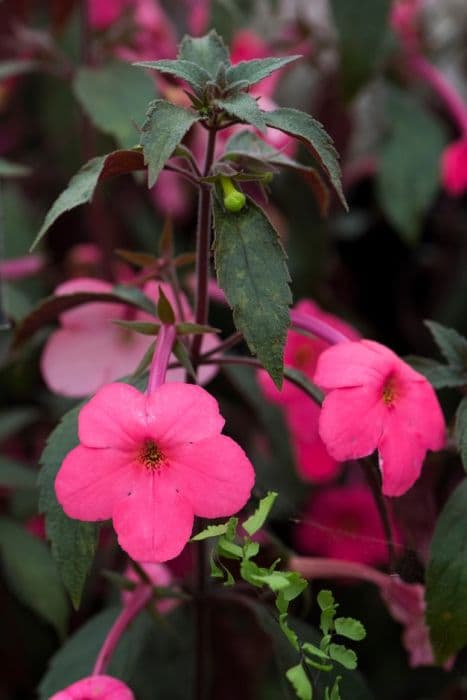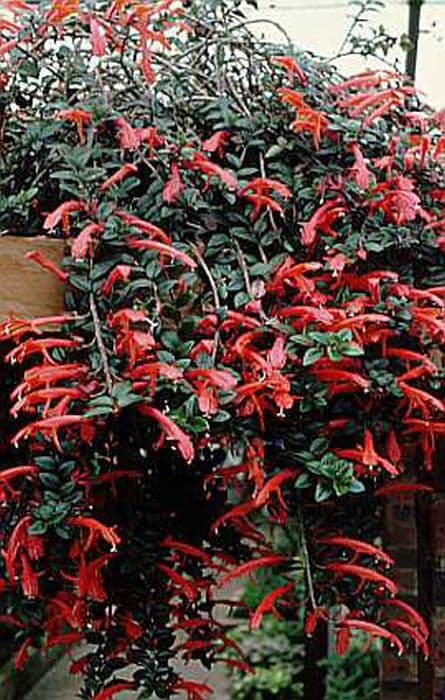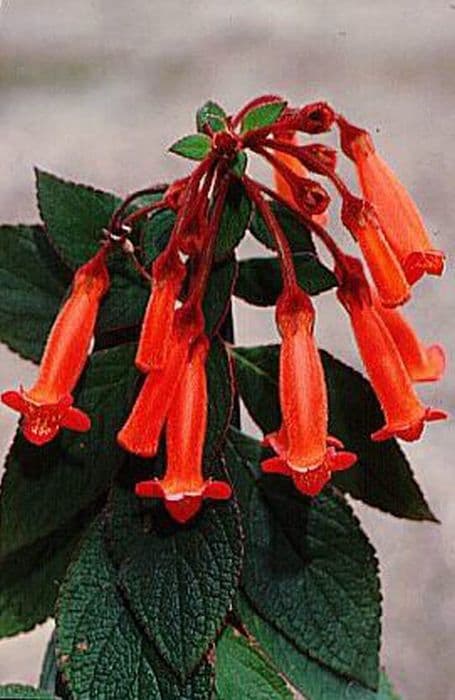Cape primrose 'Harlequin Lace' Streptocarpus 'Harlequin Lace' (PBR)

ABOUT
'Harlequin Lace' is a compact, evergreen, perennial plant with small strappy leaves, that are softly hairy and wrinkled, and large blooms borne over a long season. These are a pale bluish-purple above with the lower lobes blotched and veined in dark purple on a yellowish- white background
About this plant
 Names
NamesFamily
Gesneriaceae
Synonyms
Cape Primrose, African Violet
Common names
Streptocarpus 'Harlequin Lace' (PBR).
 Characteristics
CharacteristicsLife cycle
Perennials
Foliage type
Evergreen
Color of leaves
Green
Flower color
Mixed
Height
6 inches (15 cm)
Spread
6 inches (15 cm)
Plant type
Herb
Hardiness zones
10
Native area
Africa
Benefits
 General Benefits
General Benefits- Easy to Care For: Streptocarpus 'Harlequin Lace' is a low-maintenance plant, ideal for busy plant lovers or beginners.
- Aesthetic Appeal: It has unique and attractive foliage, with velvety leaves and beautiful, intricate flowers that can add visual interest to any indoor space.
- Long Flowering Period: This plant typically has a lengthy blooming season, providing colorful blossoms for an extended period.
- Compact Growth: Its compact size makes it suitable for small spaces such as apartments and offices.
- Non-Toxic: It is safe for homes with pets, as it is not known to be toxic to cats or dogs.
- Adaptable: It can adapt to various indoor lighting conditions, making it versatile for different locations within a home or office.
- Improves Wellbeing: Like many houseplants, it can contribute to a sense of well-being and may help reduce stress, enhance mood, and increase productivity.
 Medical Properties
Medical PropertiesThis plant is not used for medical purposes.
 Air-purifying Qualities
Air-purifying QualitiesThis plant is not specifically known for air purifying qualities.
 Other Uses
Other Uses- Photography Prop: Due to its attractive flowers, Streptocarpus can be used as a subject or background in floral photography and macro photography.
- Educational Tool: It can be utilized in schools or educational programs to teach students about plant care and botany, especially regarding flowering indoor plants.
- Nature-Inspired Art: Artists may use the Streptocarpus as inspiration for paintings, drawings, or textile designs due to its intricate patterns and vibrant colors.
- Color Therapy: The bright and varied colors of the Streptocarpus flowers can be used in color therapy sessions to promote relaxation and well-being.
- Event Decorations: The plant can be used in event decoration for weddings or parties, providing a natural and elegant touch to table settings or venue styling.
- Floral Arrangements: Its blooms can be incorporated into live floral arrangements to add beauty and a touch of uniqueness, particularly in high-end or designer flower shops.
- Theme Gardens: Streptocarpus can be included in a "literary" theme garden, where each plant represents a character or an aspect in popular novels or plays due to its dramatic appearance.
- Craft Projects: The flowers and leaves of Streptocarpus can be used in crafts, like pressing for bookmarks or stationery or incorporated into handmade wreaths and decorations.
- Collectors' Item: For plant enthusiasts and collectors, cultivating rare or unusual varieties of Streptocarpus, like 'Harlequin Lace', can be a rewarding hobby and a way to connect with other collectors.
- Feng Shui: Streptocarpus can be placed in areas of the home based on Feng Shui principles to help create balance and positive energy, due to its lush foliage and lively blooms.
Interesting Facts
 Feng Shui
Feng ShuiThe Cape Primrose is not used in Feng Shui practice.
 Zodiac Sign Compitability
Zodiac Sign CompitabilityThe Cape Primrose is not used in astrology practice.
 Plant Symbolism
Plant Symbolism- Resilience: Streptocarpus, often known as Cape Primrose, tends to thrive with minimal care, symbolizing the ability to endure and grow through adversity.
- Enduring Beauty: With its attractive foliage and long-lasting blooms, Cape Primrose represents lasting beauty and charm that endures over time.
- Adaptability: Cape Primrose can adapt to various light conditions, signifying flexibility and the capacity to thrive in different environments.
- Vibrancy: The vivid colors of the 'Harlequin Lace' blooms convey vibrancy and enthusiasm, symbolizing a lively spirit and a zest for life.
- Optimism: The bright and uplifting appearance of the flowers can represent positivity and an optimistic outlook on life's challenges.
 Water
WaterCape Primrose prefers consistent moisture, so water when the top inch of soil feels dry to the touch, which may equate to watering approximately once a week. Use room temperature water to lightly moisten the soil, providing enough to saturate the roots without leaving the plant in standing water, which could encourage root rot. On average, providing about 8-16 ounces of water should be sufficient depending on the size of the pot and the indoor environment. During the winter months, reduce watering frequency as the plant enters a dormancy phase. It's crucial not to wet the leaves or crown of the plant to prevent fungal diseases.
 Light
LightCape Primrose thrives in bright, indirect light conditions, which can be provided by placing the plant near an east or north-facing window where it can be protected from the harsh afternoon sun. Direct sunlight can scorch the leaves, so ensure diffused light, especially during the summer months. If natural light is inadequate, supplement with grow lights to maintain the health and vibrancy of the plant.
 Temperature
TemperatureCape Primrose prefers moderate temperatures and does well in a typical indoor range of 65-75°F. It is important to keep the plant away from cold drafts and sudden temperature changes which can be detrimental to its health. Ensure that the temperature does not drop below 50°F, as cold temperatures can damage the plant. Cape Primrose is not frost hardy and should be kept in a temperature-controlled environment.
 Pruning
PruningPruning Cape Primrose encourages bushier growth and triggers blooming. Deadhead spent blooms regularly to maintain aesthetics and promote further flowering. Prune back leggy stems in early spring, which is the best time for heavier pruning, to rejuvenate the plant's shape. Doing this once or twice a year is typically sufficient.
 Cleaning
CleaningAs needed
 Soil
SoilCape Primrose prefers a well-draining soil mix with added perlite or vermiculite. Keep soil pH slightly acidic to neutral, around 6.0 to 7.0, for optimal growth.
 Repotting
RepottingCape Primrose should be repotted every year or two, or when it outgrows its container, to refresh the soil and encourage health.
 Humidity & Misting
Humidity & MistingCape Primrose thrives at moderate humidity levels, ideally between 50% to 60%, avoiding overly dry or overly humid conditions.
 Suitable locations
Suitable locationsIndoor
Provide bright, indirect light and keep moist.
Outdoor
Shelter from direct sun with moist, well-draining soil.
Hardiness zone
10-11 USDA
 Life cycle
Life cycleStreptocarpus 'Harlequin Lace' begins its life cycle with seed germination, typically occurring in warm, moist soil conditions, where tiny, delicate seedlings emerge. As these seedlings grow, they develop into a rosette of elongated, fuzzy leaves characteristic of the Cape Primrose. The plant then enters a vegetative stage where it focuses on leaf growth and establishing a strong root system. After reaching maturity, Cape Primrose produces intricate and colorful trumpet-shaped flowers, which can bloom continuously under the right conditions, often for extended periods throughout the year. Following pollination, flowers eventually give way to seed capsules, which, when mature, release seeds to begin the cycle anew. In the absence of pollination or when grown indoors, gardeners may propagate the plant vegetatively by leaf cuttings to create clones of the parent plant.
 Propogation
PropogationPropogation time
Spring-Early Summer
The Streptocarpus 'Harlequin Lace', commonly known as Cape Primrose, can be propagated most effectively through leaf cuttings. The ideal time to undertake this method is during the spring or early summer when the plant is actively growing. To propagate, a healthy, mature leaf is selected and a portion of it is cut across, ensuring that a generous piece of the leaf vein is included. This leaf fragment is then placed on top of a well-draining potting mix, gently pressing it down to make contact with the soil. The cutting should be kept in a warm, bright spot out of direct sunlight, maintaining a consistent level of moisture without overwatering. Roots usually develop within a few weeks, after which small plantlets will emerge from the base of the cutting or along the cut vein, ready to be potted on when they're large enough to handle.









